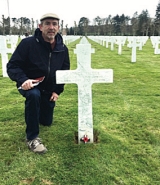| ||||||||||||||||
| Category: Fiction:Historical |
(requires Adobe Reader)
|
| About the Book | |
|
In his first inaugural address, President Reagan spoke of a soldier killed in the First World War. The young man kept a journal, in which he'd penned a vow to work, save, sacrifice and endure "and to do my utmost, as if the issue of the whole struggle depended on me alone." The "Soldier's Pledge" found its way onto a Liberty Bond Drive poster, but it was largely forgotten until the President's 1981 speech. The young soldier was Martin Treptow. He grew up in northwest Wisconsin, first on a farm near Chippewa Falls, and then in Bloomer, where his parents built a home in the village. He attended barber college in Minneapolis as a teenager, and eventually moved to Cherokee, Iowa where he found work, made friends, fell in love, and eventually joined Company M of the 168th Iowa Infantry of the famed 42nd "Rainbow Division." He was killed in France on July 28th, 1918. They Call Me Trep follows Martin from northern Wisconsin, to Iowa, to France, and back home to Bloomer. Several of Martin's letters to friends in Cherokee are included, as well as excerpts from the journals he kept. There are photographs of the farm, his home in town, and Cherokee in the early 20th Century. There also are photographs of Martin and the woman he loved, and his unit in France. They Call Me Trep is not a pure biography, however. Following President Reagan's speech, that ground was well covered by The New York Times and other media outlets. While They Call Me Trep is chronologically accurate, and features real people, it also employs fictional elements to educate readers about life in the Upper Midwest at the turn of the century, and about the First World War. There are strong women in the story, and famous characters, but it's neither a paean to political correctness, nor Forrest Gump 2.0. The women’s impressive personalities need no embellishment, and every encounter with a famous personage could have happened, and one almost certainly did. The story concludes with a curtain call, which identifies the real historical characters, and provides another peek into their lives.
|
|
| Related Title | |
|
|
| About the Author | |
 |
Bob Spurlock has lived in Phoenix for the past 40 years. He grew up in Northern Wisconsin, and has had an interest in history - especially of the Upper Midwest - for most of his life. He's written travel articles, and a short-lived sports column, but this is his first book. |

